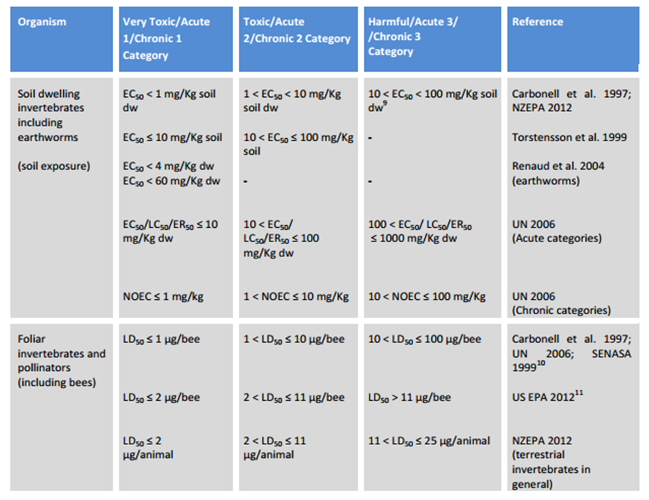Terrestrial Toxicity
Little Pro on 2016-03-28
Terrestrial toxicity is defined as the study of the effects of a chemical substance to terrestrial organisms and terrestrial plants. For many agrochemicals, assessment of their terrestrial toxicity is critical for protecting our ecosystem.
Species often used in terrestrial toxicity testing include earthworms, soil micro-organisms, plants, birds and bees. The table below summarizes the main testing guidelines for terrestrial toxicity, species used and end-points that need to be recorded.
| Species | Guidelines | Dose Descriptor |
|---|---|---|
| Earthworm | OECD 207 Earthworm, Acute Toxicity Tests, OECD 220 Enchytraeid Reproduction Test, OECD 222 Earthworm Reproduction Test (Eisenia fetida/Eisenia andrei). | LC50 (for acute), ECx, NOEC |
| Soil Micro-organism | OECD 216 Soil Microorganisms: Nitrogen Transformation Test, OECD 217 Soil Microorganisms: Carbon Transformation Test | ECx |
| Plants | OECD 227 Terrestrial Plant Test: Vegetative Vigour Test, OECD 208 Terrestrial Plant Test: Seedling Emergence and Seedling Growth Test | ECx, NOEC or LOEC |
| Terrestrial vertebrates | OECD 223 Avian Acute Oral Toxicity Test, OECD 205 Avian Dietary Toxicity Test, OECD 206 Avian Reproduction Test | NOEC or LOEC |
| Pollinators | OECD 213 Honeybees, Acute Oral Toxicity Test, OECD 214 Honeybees, Acute Contact Toxicity Test, OECD 237 Honey Bee (Apis Mellifera) Larval Toxicity Test, Single Exposure. | LD50(24h, 48h or 72h) |
| Other non-target arthropods | OECD 226 Predatory mite reproduction test in soil, OECD 228 Determination of Developmental Toxicity of a Test Chemical to Dipteran Dung Flies, OECD 232 Collembolan Reproduction Test in Soil. | NOEC or LOEC |
All testing guidelines above can be accessed here.
Regulatory Use of Terrestrial Toxicity
Under EU REACH, information on terrestrial toxicity is required for chemicals produced or imported in quantities > 100 tonnes/year if the results of the chemical safety assessment indicate a need for testing. The testing can be waived if terrestrial exposure is unlikely. Under global pesticide regulations, terrestrial toxicity data is often mandatory (especially for new active substances).
Hazard Classification Criteria for Terrestrial Toxicity
GHS has harmonized classification criteria for aquatic hazards. For non-aquatic hazards, there is no harmonized classification criteria. Environmental terrestrial hazard classification criteria for chemical substances are found in various scientific literature, international legislations and official reports.
Nanna B. Hartmann etc has summarized common classification criteria in their report Review of available criteria for non-aquatic organisms within PBT/vPvB frameworks. The picture below is a screen shot for the classification criteria for toxicity to earthworms and bees from the report.

Click here to read the full report.
Risk Assessment and Terrestrial Toxicity
LC50/LD50/NOEC/LOECs obtained via terrestrial toxicity studies will be divided by various assessment factors to calculate Predicted No Effect concentrations(PNEC) for the terrestrial environment. Please read how to calculate PNECs.
 |
Congratulations! You have learned the definition of terrestrial toxicity, tested species, testing guidelines, dose descriptors, hazard classfication criteria for terrestrial toxicityand how they are used for environmental risk assessment. |
Continue Learning...
- Aquatic toxicity
- Degradation (biotic and abiotic)
- Bio-accumulation
- Terrestrial toxicity
- Soil Adsorption Coefficient (Kd/Koc)
Having Questions?
We do not provide consultancy services. If you have questions or need any help, please contact our sponsor. You may also find an expert in CSP business directory below. If you are a consultant, you may get yourself listed in CSP business directory (free) or sponsor this page to leave your contact info on this page..

Tags: Topics - CRA, Environmental Risk Assessment